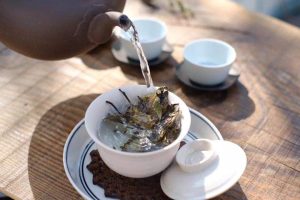
Rinsing tea leaves before brewing is recommended for several reasons:
Removing dust and impurities: During the processing, handling, and packaging of tea, some dust and small particles may find their way into the tea leaves. Rinsing helps to remove these undesirable elements, ensuring a cleaner and more pleasant brew.
Unfolding the leaves: Tea leaves are often tightly rolled or folded during processing to preserve their freshness. Rinsing allows the leaves to unfurl, which is essential for maximizing the flavor release during brewing.
Awakening the leaves: By briefly rinsing the leaves with hot water, you “awaken” them, preparing them for brewing. This process can enhance the taste and aroma of the tea.
Reducing bitterness and astringency: Some teas, especially certain types of green teas and Pu-erh teas, can be bitter or astringent if brewed without rinsing. Rinsing helps to remove some of the bitter compounds, resulting in a smoother and more balanced flavor profile.
Temperature stabilization: Rinsing the tea leaves with hot water also helps to warm the teapot or brewing vessel, preventing a sudden temperature drop when you add the water for brewing. Consistent water temperature is crucial for a successful tea infusion.
Creating a clean base for brewing: By rinsing the tea leaves, you remove any residual flavors from previous infusions, ensuring that the first proper brew is not affected by any previous brew’s taste.
It’s important to note that while rinsing is beneficial for certain types of tea, it might not be necessary for others. For example, delicate teas like white teas or some high-quality green teas may not require rinsing. On the other hand, heavily fermented teas like Pu-erh and some aged oolongs usually benefit greatly from rinsing.
Ultimately, whether or not to rinse your tea leaves before brewing depends on the type of tea and your personal preference. Some tea connoisseurs prefer to rinse all teas, while others may choose to skip this step for certain varieties. Experimenting with rinsing can help you discover the approach that best suits your taste and yields the most enjoyable cup of tea.
What you should remember is that rinsing tea leaves properly can significantly impact the flavor of your brewed tea.
Here’s a step-by-step guide on how to rinse tea leaves properly:
-
Measure the tea leaves: Start by measuring the appropriate amount of tea leaves. The amount will depend on the type of tea and your personal preference. Generally, a good guideline is 1 teaspoon of loose tea leaves per 240 ml of water.
-
Prepare the teapot or vessel: Use a teapot or any other suitable vessel to brew your tea. Make sure it’s clean and free from any residues of previous brews.
-
Add the tea leaves: Place the measured tea leaves into the teapot.
-
Heat the water: Boil fresh, clean water to the appropriate temperature for the type of tea you’re brewing. Different teas require different water temperatures to bring out their best flavors. For example, green tea is best brewed with water around 80°C, while black tea can be brewed with water at 93-100°C. Refer to the specific brewing instructions for your tea type.
-
Rinse the tea leaves: Once the water has reached the correct temperature, pour it over the tea leaves in the teapot. Swirl the water around gently, ensuring all the tea leaves are wet. Then, immediately pour out the water from the teapot into a separate container. This is the rinsing step and should only last for a few seconds. The purpose is to remove any small particles and dust from the leaves, which can negatively affect the taste.
-
Discard the water: The water used to rinse the tea leaves should be discarded. Do not use it for brewing your tea, as it’s mainly intended to cleanse the leaves.
-
Brew the tea: After rinsing, proceed to brew your tea as usual. Pour the appropriate water temperature over the rinsed tea leaves and let it steep for the recommended time, according to your tea type and personal preference.
-
Enjoy your tea: Once the steeping time is up, pour the brewed tea into your teacup and savor the flavors and aromas that have been properly released through the rinsing process and the subsequent brewing.
Remember that the precise steps and times can vary depending on the specific type of tea you are brewing, so always consult the packaging or the supplier’s recommendations for the best results. With practice, you’ll be able to fine-tune your rinsing technique and enjoy the best possible cup of tea.